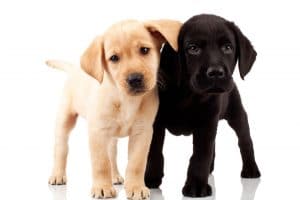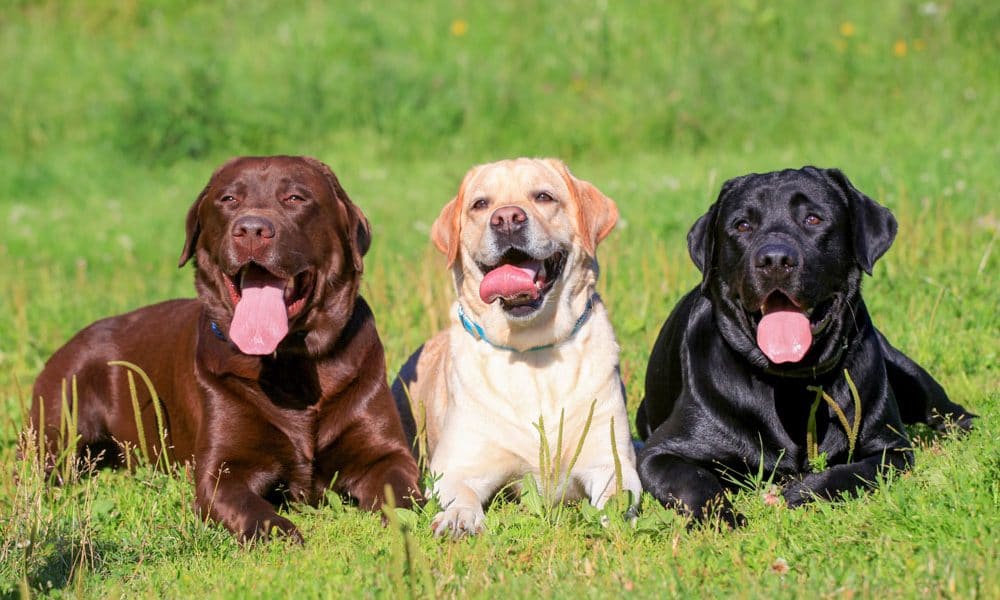A Lab of A Different Colour? Learn more about coat colour genetics in Labrador Retrievers
Imagine this: You have a fully registered black lab. She is the apple of your eye and the pride in your punch. You are fully anticipating the birth of her new pups, bred from a sire that can trace his royal black blood to the dawn of labrador. The anticipated moment arrives and oh my god, there’s a yellow puppy! How did this happen? Did you leave the back door open for some scoundrel to defile your princess? Or is she not the princess you bought her to be? Nonsense! It’s genetics!
 The truth is your lab is just as pure as the driven snow, but yellow is sort of a double recessive gene in labs, much like green eyes are with humans. The only colours recognised by the Kennel Club for a true lab are black, brown, and yellow. Brown has also been called chocolate or liver. The yellow has the most varying degrees of shade as they can be nearly white all the way to vibrant red in their hue. Now, genetics are a fine art, one I have not raised brush or bristle to, so I will not pretend to be a quotable expert in the field, but there are some insights I can provide that may give you some idea of what your future grandpups might look like!
The truth is your lab is just as pure as the driven snow, but yellow is sort of a double recessive gene in labs, much like green eyes are with humans. The only colours recognised by the Kennel Club for a true lab are black, brown, and yellow. Brown has also been called chocolate or liver. The yellow has the most varying degrees of shade as they can be nearly white all the way to vibrant red in their hue. Now, genetics are a fine art, one I have not raised brush or bristle to, so I will not pretend to be a quotable expert in the field, but there are some insights I can provide that may give you some idea of what your future grandpups might look like!
Black is the dominant colour among labs. It is represented by a capital B. Brown is recessive so it is represented by a lowercase b. The yellow comes in as a “switch” gene, represented as both dominant/recessive E/e. Black (B) will always trump brown (b), but if a recessive yellow (e) is present, it will switch the dominant gene and your pup will be yellow. Dominant yellow (E) switches off the masking gene or the recessive (e) .Clear as mud? It should be! In order to work out for yourself what the combinations for your dog and a known partner, you will need to use the Punnett Square, which I’m sure you’ll remember from those glorious days of high school science lab. If you are just working out black/brown colour, you would arrive with 4 possibilities.
Labs receive two B(b)s and two E(e)s accordingly, so your black lab can be a carrier for brown or yellow genes. Contrary-wise, breeding two yellow labs should only produce yellow pups as they don’t have the gene to switch off the masking effect of the recessive (e). Have you worked out the combinations yet? There are nine:
Genotype Phenotype
EEBB Black
EEBb Black
EEbb Brown
EeBB Black
EeBb Black
Eebb Brown
eeBB Yellow
eeBb Yellow
eebb Yellow
 This is by far the simplest breakdown I can give you and genetic enthusiasts reading this column are quite possibly stamping and snorting at all the information I skimmed the surface of or left out entirely. As for minute clarification I say, see a specialist! Not only can they provide the breakdown of your lab genetically, they can specify what kind of pups you can expect from breeding with various sires.
This is by far the simplest breakdown I can give you and genetic enthusiasts reading this column are quite possibly stamping and snorting at all the information I skimmed the surface of or left out entirely. As for minute clarification I say, see a specialist! Not only can they provide the breakdown of your lab genetically, they can specify what kind of pups you can expect from breeding with various sires.
The best way to find out how many colours your dog is carrying is to send swab samples to a veterinary genetic testing service. This service may be provided for you through your regular vet and some pet stores also offer genetic testing as well. If you are not sure where to start on your search, check out www.vetgen.com or just type veterinary genetic testing in your search engine. You will be amazed at the sheer amount of information out there, but be diligent and you will find the best solution for you.
Love Labrador Retrievers and want to find out more about the breed? We put together a breed profile here.


